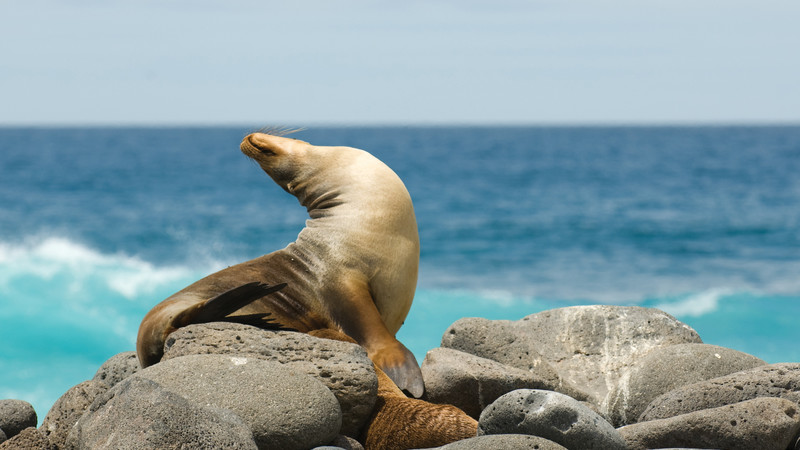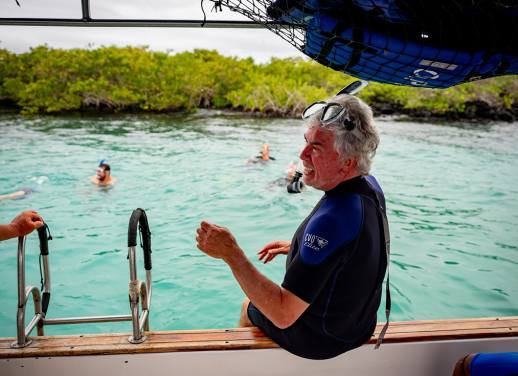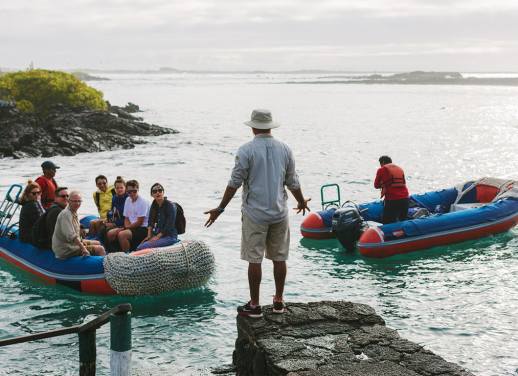After months of saving and planning, it’s finally happening – you’re going to the Galapagos Islands! Soon you’ll be snorkelling with giant sea turtles, sunbathing with marine iguanas and keeping your eyes peeled for those famous finches that inspired Darwin’s research.
Not surprisingly, a Galapagos trip involves some long days under the sun and frequent boat rides between islands. To make sure you get the most out of exploring this amazing archipelago, rather than being overcome with seasickness or reeling from a lobster-red sunburn, you need to be prepared.
Here’s our list of essential items to pack so that you can make the most of your adventure in the Galapagos.
Sun protection
Sunscreen: Look for sunscreen that is biodegradable, waterproof and at least SPF 30. Apply liberally and often in the Galapagos Islands, even if it’s cloudy. Remember to allow time for the sunscreen to sink in before entering the water.
Rash guard or swim shirt: Many travellers don’t realise UV rays can still penetrate water, causing damage to your skin even while you’re snorkelling or swimming alongside sea lions. Unlike a simple t-shirt, rash guards and swim shirts have built-in UV protection and don’t get heavy when wet.
Sunglasses: Look for sunglasses with polarised lenses, which help to minimise glare when light from the sun is reflected off the water. Not only will they shade your eyes, they also make it easier to spot marine life in the water.
Sun hat: It might not be particularly fashionable, but a sun hat or wide-brimmed hat gives your ears and neck necessary protection from the harsh equatorial sun.
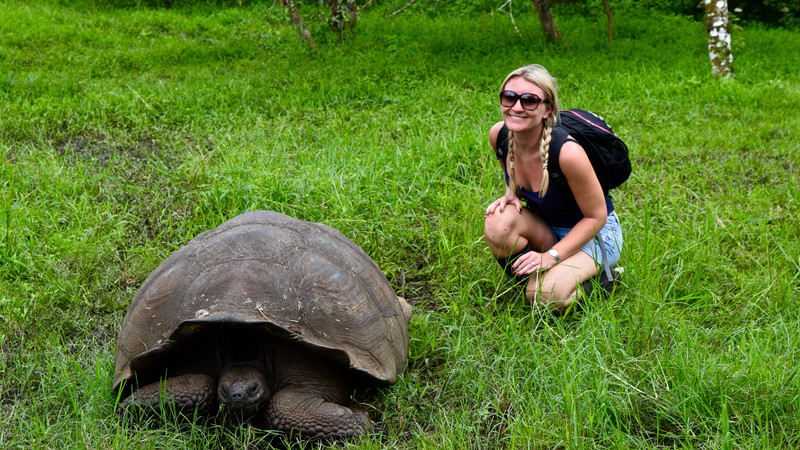
Pack a waterproof day bag to carry with you on expeditions.
Footwear
Water shoes or sturdy sandals: Some islands require a wet landing to visit, which means you disembark from your boat into the water and then wade to shore. While you can certainly choose to go barefoot, waterproof shoes offer better protection from underwater rocks (and less bruised toes). Alternatively, bring sandals with hard soles and a heel strap.
Comfortable walking shoes or light hiking boots: Hiking in the Galapagos is not strenuous, but the ground can be uneven and rocky in places. You’ll want close-toed shoes with good traction, and don’t forget breathable hiking socks to avoid blisters.
Clothing
Comfortable clothing for warmer temperatures: Temperatures are pleasant year-round in the Galapagos, ranging from humid 30°C (86°F) days during the warm season between January and May, to balmy 25°C (77°F) days during the cool season from July to December. While you’ll be comfortable in t-shirts and shorts any time of the year, long, loose clothes offer better protection from the sun and keep you cooler on especially hot days.
Fleece or warm jumper: For mornings and evenings during the cooler season, when temperatures can feel colder due to the cool sea current.
Light raincoat or poncho: Particularly during the warm season when short, daily periods of rainfall are common.
Swimsuit: Bring at least two that you can alternate wearing so you never have to put on a soggy suit.
RELATED CONTENT: THE BEST AND WORST TIMES TO VISIT THE GALAPAGOS ISLANDS
Medication
First-aid kit: If you’re travelling on a Galapagos tour with Intrepid, your leader will always have a first-aid kit, but it’s always a good idea to carry some of your own supplies such as Band-Aids, mild painkillers, aloe gel for sunburn and indigestion tablets.
Motion sickness medication: Waters around the Galapagos are generally pretty calm but, as any weather forecaster will tell you, you can never predict Mother Nature. Some tours also use speedboats to carry travellers between the islands, which can be a bumpy ride. Those prone to motion sickness have a couple of options. Over-the-counter drugs prevent seasickness, though often cause drowsiness. A scopolamine patch provides three days of relief. Many also swear that ginger (in candy, tea or pill form) is an effective remedy. If you’re someone who suffers seasickness, read our more detailed guide to managing seasickness.
Water bottle, purification tablets: Water generally isn’t safe to drink in the Galapagos. For environmental reasons, it’s always best to carry a reusable canteen that can be refilled as needed rather than buy bottled water. A good idea is to pack purification tablets, so you can filter your own water instead of searching for it on the islands. If you’re travelling on an Intrepid Galapagos Island sailing trip, you’ll be provided with purified water on board your boat. Similarly, you’ll find filtered water available at the hotels we stay in on our overland trips.
Hand sanitizer and toilet paper: Soap and toilet paper frequently run out or just aren’t provided in public bathrooms – carry your own to avoid a tricky situation.
Insect repellent: The Galapagos doesn’t have many mosquitoes or insects that bite but it doesn’t hurt to pack a small bottle just in case. On some islands, temporary mangroves can develop when the tide goes out – meaning mosquitoes might be more likely to bite you.
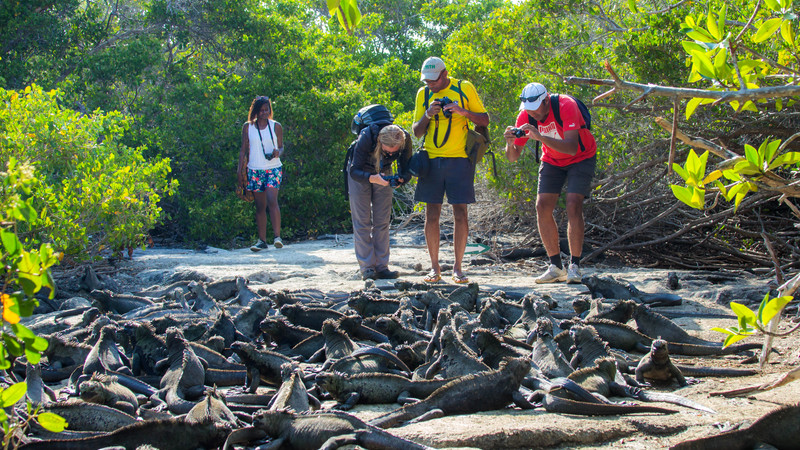
Don’t forget to pack a camera and extra batteries.
Optional extras
Day bag: You’ll be setting out on a number of day expeditions to the islands, so it’s a good idea to bring along a small, comfortable day bag to carry with you. There’ll be wet landings so ideally you should bring a bag that can handle getting wet (while also protecting your camera and valuables inside).
Snorkel and mask: You’ll be able to rent these on the islands, though bring your own if you’re fussy about sharing or simply want to guarantee your mask fits properly. Snorkel and masks are provided on Intrepid’s Galapagos Island sailing trips.
Good camera: Spend a couple of hours on San Cristobal Island and you’ll quickly find you can never have too many photos of lounging sea lions. Or any other adorable creature that lives on the islands for that matter. Bring a waterproof camera if you have one, lots of extra memory and a spare camera battery. There’s nothing worse than missing out on the perfect shot because your battery has hit 0%.
Binoculars: Do you know your flightless cormorant from your frigatebird and blue-footed boobie? With over 150 different species of bird life spread out across the islands, keen birdwatchers will be glad they packed these. Binoculars might also come in handy for spotting whales in the distance.
Finally, it’s worth remembering that you’ll be carrying your bags on and off boats between the islands, so pack light. Another option is to bring an extra bag for the islands and ask your hotel on the mainland to store your luggage while you’re away exploring.
All packed and ready to go? Check out our Galapagos tours.

